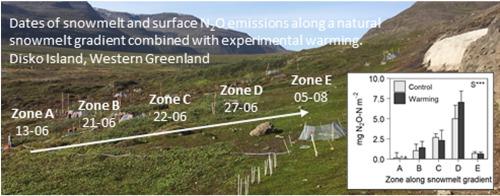Soil Biology and Biochemistry ( IF 9.7 ) Pub Date : 2021-06-21 , DOI: 10.1016/j.soilbio.2021.108346 Elisabeth Kolstad , Anders Michelsen , Per Lennart Ambus

|
Climate change is profound in the Arctic where increased snowfall during winter and warmer growing season temperatures may accelerate soil nitrogen (N) turnover and increase inorganic N availability. Nitrous oxide (N2O) is a potent greenhouse gas formed by soil microbes and in the Arctic, the production is seen as limited mainly by low inorganic N availability. Hence, it can be hypothesized that climate change in the Arctic may increase total N2O emissions, yet this topic remains understudied. We investigated the combined effects of variable snow depths and experimental warming on soil N cycling in a factorial field study established along a natural snowmelt gradient in a low Arctic heath ecosystem. The study assessed N2O surface fluxes, gross N mineralization and nitrification rates, potential denitrification activity, and the pools of soil microbial, soil organic and soil inorganic N, carbon (C) and phosphorus (P) during two growing seasons. The net fluxes of N2O averaged 1.7 μg N2O–N m−2 h−1 (range −3.6 to 10.5 μg N2O–N m−2 h−1), and generally increased from ambient (1 m) to moderate (2–3 m) snow depths. At the greatest snow depth (4 m) where snowmelt was profoundly later, N2O fluxes decreased, likely caused by combined negative effects of low summer temperatures and high soil moisture. Positive correlations between N2O and nitrate (NO3−) and dissolved organic N (DON) suggested that the availability of N was the main controlling variable along the snowmelt gradient. The maximum N2O fluxes were observed in the second half of August associated with high NO3− concentrations. The effect of growing season experimental warming on N2O surface flux varied along the snowmelt gradient and with time. Generally, the experimental warming stimulated N2O fluxes under conditions with increased concentrations of inorganic N. In contrast, warming reduced N2O fluxes when inorganic N was low. Experimental warming had no clear effects on soil inorganic N. The study suggests that if increased winter precipitation leads to a deeper snow cover and a later snowmelt, total emissions of N2O from low Arctic heath ecosystems may be enhanced in the future and, dependent on dissolved N availability, summer warming may stimulate or reduce total emissions.
中文翻译:

低北极荒地中的一氧化二氮表面通量:沿着自然融雪梯度的实验变暖的影响
北极地区的气候变化非常严重,冬季降雪量增加和生长季节温度升高可能会加速土壤氮 (N) 周转并增加无机氮的可用性。一氧化二氮 (N 2 O) 是一种由土壤微生物形成的强效温室气体,在北极地区,其生产主要受到无机氮可用性低的限制。因此,可以假设北极的气候变化可能会增加 N 2 O 的总排放量,但该主题仍未得到充分研究。我们在北极低荒地生态系统中沿自然融雪梯度建立的因子实地研究中,研究了不同雪深和实验性变暖对土壤氮循环的综合影响。该研究评估了 N 2O 表面通量、总氮矿化和硝化速率、潜在的反硝化活性,以及两个生长季节期间土壤微生物、土壤有机和土壤无机氮、碳 (C) 和磷 (P) 的库。N 2 O的净通量平均为 1.7 μg N 2 O–N m -2 h -1(范围 -3.6 至 10.5 μg N 2 O–N m -2 h -1),并且通常从环境 (1 m) 增加到中等 (2–3 m) 雪深。在最大雪深 (4 m) 处,融雪时间很晚,N 2 O 通量下降,这可能是由于夏季低温和土壤湿度高的综合负面影响造成的。N 2之间的正相关O 和硝酸盐 (NO 3 - ) 和溶解有机 N (DON) 表明 N 的可用性是沿融雪梯度的主要控制变量。在与高 NO 3 -浓度相关的 8 月下半月观察到最大 N 2 O 通量。生长季实验增温对 N 2 O 表面通量的影响沿融雪梯度和时间变化。一般来说,在无机 N 浓度增加的条件下,实验性变暖刺激了 N 2 O 通量。相反,变暖减少了 N 2当无机 N 低时,O 通量。实验性变暖对土壤无机氮没有明显影响。研究表明,如果冬季降水增加导致积雪更深,融雪更晚,未来北极低健康生态系统的 N 2 O总排放量可能会增加,并且依赖于在溶解氮的可用性方面,夏季变暖可能会刺激或减少总排放量。



























 京公网安备 11010802027423号
京公网安备 11010802027423号